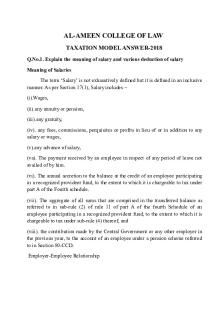Taxation FBT notes PDF

| Title | Taxation FBT notes |
|---|---|
| Author | Thomas Coleman |
| Course | Taxation |
| Institution | The University of Notre Dame (Australia) |
| Pages | 13 |
| File Size | 1 MB |
| File Type | |
| Total Downloads | 56 |
| Total Views | 159 |
Summary
Taxation - FBT notes...
Description
Taxation: Fringe Benefit Tax (FBT) notes Chapter 19 – Foundations of Australian Taxation Law Introduction ● The FBT regime is a tax on a wide range of benefits provided by an employer to an employee ● The fringe benefits tax regime is a tax on a wide range of benefits provided by an employer to an employee. ● FBT provisions are contained in the: - Fringe Benefits Tax Assessment Act 1986 (“FBTAA”). - Fringe Benefits Tax Act 1986 ● Key differences between income tax and FBT include: - Tax is levied on the employer, not employee on the provision of fringe benefits - FBT year is from 1 April to 31 March, being the “year of tax” Liability to pay FBT
� FBT = (FB taxable value x gross up) x 47% •
• • •
To neutralize the distinction between fringe benefits and salary, the formulas in s 5B require employers to multiply the taxable values of their fringe benefits by special ‘gross-up’ rates - Gross-up rates are designed to prevent a bias in favour of employees receiving fringe benefits instead of salary under the ‘salary-packaging arrangements’ Year of tax runs from 1 April to 31 March FBT rate is currently 47% Deductibility: - The cost of paying FBT is deductible for income purposes
Assessment and payment of FBT • • • • •
Employers required to self-assess FBT Employers must lodge FBT returns by 21 May following the end of the year of tax, or such later date as the Commissioner allows Employers are generally liable to pay quarterly instalments of FBT and report these on their activity statements FBT instalments credited against their actual FBT liability for the year FBT and the cost of benefits are generally deductible to employers under s 8-1 ITAA97
Definition of a fringe benefit ● Central to the imposition of FBT is the term “fringe benefit” as defined in s 136(1) FBTAA. ● Under the positive limbs, a fringe benefit exists where there is:
1
● Specific exclusions apply, e.g. salary or wages ● The term “benefit” includes any right, privilege, service or facility provided under an arrangement in relation to the performance of work (s 136(1)): - Very wide definition that will likely capture most benefits, including non-monetary benefits - Exclusions apply – i.e. the negative limbs of the definition excluding ‘salary or wages’, ‘exempt benefits’ and a range of ‘other benefits’ from being fringe benefits ● There are 13 specific categories of fringe benefits, including a ‘residual benefit’ category which is a ‘catchall’ category ● Under s 136(1), the term “provide” means: - In relation to a benefit: includes “allow, confer, give, grant or perform”; and - In relation to property: disposal of a beneficial interest in or legal ownership of the property. ● “Provided” also includes where provision of the benefit is prohibited but the prohibition is not consistently enforced: - E.g. an employer “turns a blind eye” to employee’s private use of an employer-provided motor vehicle.
Exclusions ● The definition of a fringe benefit specifically excludes certain benefits from being a fringe benefit: - Salary, wages and allowances (most important exclusion) - Benefits under an employee share scheme - Deemed dividends - Restraint of trade and personal injury payments of a capital nature - Termination, unused annual leave and long service leave, early retirement and redundancy payments - Superannuation contributions and benefits ● There are also a number of miscellaneous exempt benefits: - Car-related benefits when a car fringe benefit is provided - Benefits provided by certain registered benevolent and health care providers - Minor benefits with a taxable value...
Similar Free PDFs

Taxation FBT notes
- 13 Pages

Taxation notes
- 54 Pages

FBT Seminar - final version
- 6 Pages

Topic 05 FBT - Lecture notes 5
- 20 Pages

Adv Tax.Study Guide - Ch8(FBT)
- 25 Pages

Notes LAW OF Taxation
- 271 Pages

Taxation CGT Notes
- 8 Pages

Taxation Notes CPA 2
- 340 Pages

Taxation - Lecture notes 1
- 29 Pages

Taxation Law Exam Notes
- 65 Pages

Taxation Notes - summaries
- 3 Pages

Business Taxation notes 8
- 2 Pages

Taxation Law Exam Notes
- 3 Pages

Income Taxation Notes- Complete.pdf
- 116 Pages

Taxation law wk10 - notes
- 9 Pages

Taxation revision notes
- 18 Pages
Popular Institutions
- Tinajero National High School - Annex
- Politeknik Caltex Riau
- Yokohama City University
- SGT University
- University of Al-Qadisiyah
- Divine Word College of Vigan
- Techniek College Rotterdam
- Universidade de Santiago
- Universiti Teknologi MARA Cawangan Johor Kampus Pasir Gudang
- Poltekkes Kemenkes Yogyakarta
- Baguio City National High School
- Colegio san marcos
- preparatoria uno
- Centro de Bachillerato Tecnológico Industrial y de Servicios No. 107
- Dalian Maritime University
- Quang Trung Secondary School
- Colegio Tecnológico en Informática
- Corporación Regional de Educación Superior
- Grupo CEDVA
- Dar Al Uloom University
- Centro de Estudios Preuniversitarios de la Universidad Nacional de Ingeniería
- 上智大学
- Aakash International School, Nuna Majara
- San Felipe Neri Catholic School
- Kang Chiao International School - New Taipei City
- Misamis Occidental National High School
- Institución Educativa Escuela Normal Juan Ladrilleros
- Kolehiyo ng Pantukan
- Batanes State College
- Instituto Continental
- Sekolah Menengah Kejuruan Kesehatan Kaltara (Tarakan)
- Colegio de La Inmaculada Concepcion - Cebu